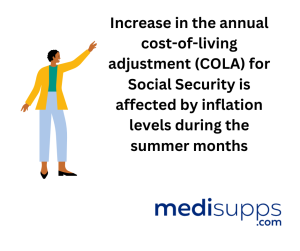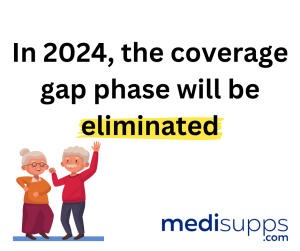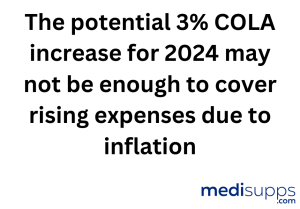
by Russell Noga | Updated September 12th, 2023
 Are you worried about “how much will social security take out for medicare in 2024”? You’re not alone. With potential changes in Social Security benefits and Medicare premiums on the horizon, many retirees are concerned about their financial futures.
Are you worried about “how much will social security take out for medicare in 2024”? You’re not alone. With potential changes in Social Security benefits and Medicare premiums on the horizon, many retirees are concerned about their financial futures.
In this article, we provide a comprehensive breakdown of the anticipated changes in Social Security and Medicare and expert insights and strategies for coping with potential shortfalls.
Buckle up as we explore the complexities of the 2024 landscape, navigating the uncertainties and providing you with valuable information for your financial planning.
Short Summary
- Social Security COLA and Medicare Part B Premiums in 2024 may decrease benefits for some retirees.
- Rising household expenses are outpacing the COLA adjustments, requiring budgeting and planning to accommodate potential increases in living costs.
- Retirees should explore supplemental insurance options to protect their financial well-being and maintain quality of life in retirement.
Projected Social Security COLA and Medicare Part B Premiums in 2024
The potential 3% increase in Social Security benefits in 2024, based on the Social Security COLA estimate, may not necessarily translate into extra cash in your pocket. Rising Medicare Part B premiums could offset this increase, leaving some beneficiaries struggling to cover their living expenses.
The projected increase in Medicare Part B premiums in 2024 ranges between $5 and nearly $15 per month for all beneficiaries, resulting in a premium of approximately $180 per month. As a result, the lowest-income Social Security recipients may see their monthly benefits barely change or even decrease.
It’s important to note that these projections are subject to change based on inflation levels. The official 2024 COLA will be declared in October once third-quarter inflation levels have been calculated.
However, it’s crucial for retirees to stay informed and prepare for the potential financial challenges that may arise from these changes, especially in light of the Inflation Reduction Act.
COLA Calculation and Its Impact on Social Security Benefits
The annual cost-of-living adjustment (COLA) for Social Security benefits is calculated using a subset of the Consumer Price Index, which measures the cost of goods and services for a certain demographic. The increase is determined by the average inflation level in July, August, and September.
This calculation directly impacts Social Security benefits, as it establishes the yearly increase in benefits based on the percentage change between the average 3rd quarter Consumer Price Index (CPI) of the current year and the average 3rd quarter CPI of the previous year.
Although the COLA is designed to help beneficiaries keep up with inflation, the reality is that many retirees still struggle to cover their rising expenses. The Senior Citizens League conducted a survey revealing that more than half of the respondents were unable to cover their rising household expenses despite the unusually high COLA for 2023.
This highlights the need for retirees to closely monitor their expenses and adjust their budgets accordingly.
Factors Affecting Medicare Part B Premiums
Medicare Part B premiums are influenced by various factors, including healthcare costs, legislative changes, and inflation. For example, the introduction of new medications or therapies, such as the recent approval of a new Alzheimer’s drug, can lead to increased costs for the Medicare program and subsequently higher premiums for beneficiaries.
Furthermore, changes in the federal government’s approach to healthcare and policy decisions can also impact the premiums that beneficiaries pay for their Medicare Part B coverage, potentially leading to a part b premium increase.
It’s essential for retirees to stay informed about these factors and how they may impact their Medicare Part B premiums in the coming years.
By understanding the driving forces behind premium increases, beneficiaries can better prepare for potential changes in their healthcare costs and adjust their financial plans accordingly.
Discover 2024 Plans & Rates
Enter Zip Code
The Senior Citizens League’s Warning
The Senior Citizens League has issued a warning to retirees, cautioning that they may face financial challenges due to rising household expenses and the limitations of the Consumer Price Index in reflecting these costs. Many retirees experience increased expenses in areas such as dental care and auto insurance, which are not accurately represented in the CPI.
As a result, the potential 3% COLA increase in 2024 may not provide sufficient support for retirees to cover their rising expenses.
By highlighting these financial pressures, the Senior Citizens League aims to raise awareness about the challenges faced by retirees and advocate for their benefits. This underscores the importance of staying informed about potential changes in Social Security and Medicare, as well as exploring strategies to cope with potential shortfalls.
Rising Household Expenses for Social Security Recipients
Despite the unprecedented 8.7% COLA for 2023, many Social Security recipients still struggle to keep up with their increasing living costs.
Expenses such as food, housing, and healthcare continue to rise, outpacing the COLA adjustments in some cases. This puts additional financial pressure on retirees, who may need to adjust their budgets and financial plans to accommodate these increases.
It’s crucial for Social Security recipients to monitor their expenses and plan for potential increases in living costs.
By staying informed about the factors driving these increases and adapting their budgets as needed, retirees can better prepare for the financial challenges they may face in the coming years.
The Role of the Consumer Price Index
The Consumer Price Index (CPI) is used to measure the average change in prices of goods and services over time, as well as to calculate the Social Security COLA.
However, the Senior Citizens League warns that the CPI may not accurately reflect the financial pressures faced by retirees, as it does not fully account for the “stubbornly high” prices of essential items such as prescription drugs, food, housing, and dental services.
This limitation of the CPI highlights the need for retirees to carefully assess their personal financial situations and consider factors beyond the COLA when planning for their future expenses.
By staying informed about the potential changes in Social Security and Medicare and exploring various strategies to cope with potential shortfalls, retirees can better prepare for the financial challenges they may face in the coming years.
Changes to Medicare Part D in 2024 and 2025
Medicare Part D will undergo significant changes in 2024 and 2025 aimed at improving the prescription drug coverage for beneficiaries. These changes include the elimination of the coverage gap phase, an increased share of drug costs paid by Part D plans, and new manufacturer price discounts.
These modifications are expected to have a considerable impact on the out-of-pocket expenses for Medicare beneficiaries, potentially easing the financial burden of prescription drug costs.
It’s important for Medicare beneficiaries to stay informed about these changes and how they may affect their prescription drug coverage.
By understanding the upcoming modifications to Medicare Part D, beneficiaries can better plan for their healthcare expenses and adjust their budgets accordingly.
Elimination of the Coverage Gap Phase
The initial coverage phase precedes the coverage gap phase, also known as the “donut hole,” which is a period during which enrollees are responsible for a larger share of their drug costs until they reach the catastrophic phase.

In 2024, the coverage gap phase will be eliminated, simplifying the Medicare Part D benefit structure and alleviating the financial burden on beneficiaries. This change means that Part D enrollees will no longer incur additional costs for their drugs during this period, potentially resulting in significant savings.
The elimination of the coverage gap phase is a welcome change for Medicare beneficiaries, who have long struggled with the financial challenges posed by this aspect of the Part D program.
By removing this barrier, beneficiaries can enjoy a more streamlined and affordable prescription drug coverage experience.
Increased Share of Drug Costs Paid by Part D Plans
Starting in 2024, Part D plans will be responsible for a higher share of drug costs, potentially reducing out-of-pocket expenses for enrollees.
Part D plans will be required to cover 20% of total drug costs during the catastrophic coverage phase, up from the current 10%. This change aims to provide financial relief to Medicare beneficiaries, as they will be responsible for a smaller portion of their prescription drug costs.
The increased share of drug costs paid by Part D plans is an important development for Medicare beneficiaries, who often struggle with the high out-of-pocket cost of medication.
By shifting more of the financial burden to the plans, beneficiaries can potentially enjoy lower out-of-pocket expenses and better access to the medications they need.
New Manufacturer Price Discounts
In addition to the changes in coverage and cost-sharing, new manufacturer price discounts will be introduced in 2024 and 2025, aiming to lower drug prices for Medicare beneficiaries. Manufacturers will be required to provide discounts on brand-name drugs in the catastrophic coverage phase, resulting in savings for Part D enrollees who take only brand-name medications and have drug costs reaching the catastrophic threshold.
These new manufacturer price discounts are a significant development for Medicare beneficiaries, who have long faced high prescription drug costs.
By mandating these discounts, the federal government is taking an important step toward making medications more affordable and accessible for those who rely on them.
Analyzing the Impact on Average Monthly Benefit
The impact on average monthly benefits will depend on various factors, including the analyses of Medicare policy experts like Mary Johnson and the outlook provided by the Medicare Trustees. These perspectives can help retirees gain a better understanding of the potential changes in Social Security and Medicare, as well as the financial challenges they may face in the coming years.
By considering these factors and staying informed about potential changes, retirees can better prepare for their financial future and explore strategies for coping with potential shortfalls.
It’s important to remember that each individual’s situation is unique, and the impact of these changes may vary depending on factors such as income, healthcare expenses, and lifestyle choices.
Mary Johnson’s Analysis as a Medicare Policy Analyst
Medicare Policy Analyst Mary Johnson’s analysis suggests that the potential 3% COLA increase for 2024 may not be enough to cover the rising expenses faced by retirees. As healthcare costs continue to escalate and inflation remains uncertain, retirees may find themselves stretched thin by the increasing cost of living.
 Johnson’s perspective emphasizes the importance of staying informed about potential changes in Social Security and Medicare, as well as the need for retirees to carefully assess their personal financial situation.
Johnson’s perspective emphasizes the importance of staying informed about potential changes in Social Security and Medicare, as well as the need for retirees to carefully assess their personal financial situation.
By taking into account expert analyses like those of Mary Johnson, retirees can gain valuable insights into the potential challenges they may face in the coming years. This knowledge can help them make informed decisions about their financial planning, ensuring they are better prepared to handle any potential shortfalls.
Outlook from the Medicare Trustees
The Medicare Trustees’ outlook provides further insight into the potential impact of changes in Social Security and Medicare on beneficiaries.
The Trustees project that gross Medicare spending will increase from 3.9 percent of GDP in 2022 to 5.4 percent in 2032 and 6.2 percent in 2045. In addition, they anticipate that the Part A trust fund will be depleted in 2028.
This outlook serves as a reminder of the financial challenges that may lie ahead for Medicare beneficiaries, as well as the importance of staying informed about potential changes in the program.
By considering the projections provided by the Medicare Trustees, retirees can gain a better understanding of the long-term trends in Medicare spending and adjust their financial plans accordingly.
Strategies for Coping with Potential Shortfalls
To cope with potential shortfalls resulting from changes in Social Security and Medicare, retirees should consider implementing various strategies. These may include budgeting and planning for rising prices, as well as exploring supplemental insurance options to cover additional expenses not covered by Medicare.
By proactively addressing potential financial challenges, retirees can better prepare for the future and maintain their quality of life.
It’s important for retirees to regularly assess their financial situation and adjust their plans as needed, taking into account changes in Social Security COLA, Medicare premiums, and other factors.
By staying informed and proactive, retirees can better adapt to the evolving financial landscape and ensure their long-term financial well-being.
Budgeting and Planning for Rising Prices
Adjusting budgets and financial plans to account for potential increases in living costs is a crucial strategy for retirees. This may involve monitoring expenses, establishing a budget, and exploring supplemental insurance options to help cover potential shortfalls.
By regularly assessing their financial situation and adapting their plans as needed, retirees can better prepare for the financial challenges that may arise from changes in Social Security and Medicare.
When planning for rising prices, retirees should consider not only the potential changes in Social Security benefits and Medicare premiums, but also the impact of inflation and other rising prices on their living expenses.
By accounting for these variables and making informed decisions about their financial planning, retirees can better navigate potential shortfalls and ensure their long-term financial security.
Exploring Supplemental Insurance Options
Supplemental insurance options can help cover additional expenses not covered by Medicare, providing financial relief for retirees facing potential shortfalls. These options include Medicare Advantage plans, Medicare Supplement plans, and long-term care insurance.
Each type of supplemental insurance provides different benefits and coverage levels, so it’s important for retirees to carefully evaluate their options and choose the plan that best meets their needs.
 By exploring supplemental insurance options, retirees can ensure that they have adequate coverage for their healthcare expenses and mitigate the financial challenges posed by changes in Social Security and Medicare. This proactive approach can help retirees maintain their quality of life and safeguard their financial well-being in the face of potential shortfalls.
By exploring supplemental insurance options, retirees can ensure that they have adequate coverage for their healthcare expenses and mitigate the financial challenges posed by changes in Social Security and Medicare. This proactive approach can help retirees maintain their quality of life and safeguard their financial well-being in the face of potential shortfalls.
Compare Medicare Plans & Rates in Your Area
Summary
In conclusion, the upcoming changes in Social Security and Medicare in 2024 and beyond may pose financial challenges for retirees.
By staying informed about the potential impact of these changes on average monthly benefits, analyzing expert insights and projections, and implementing strategies such as budgeting and exploring supplemental insurance options, retirees can better prepare for the future and maintain their financial well-being.
Remember, knowledge is power – by understanding the complexities of the 2024 landscape, you’ll be better equipped to navigate the uncertainties and secure your financial future.
Compare 2024 Plans & Rates
Enter Zip Code
Frequently Asked Questions
How much will Social Security deduct for Medicare in 2024?
In 2024, the standard Medicare Part B premium deducted from Social Security benefits is projected to be around $170.10 per month.
What determines the Medicare premium deducted from Social Security in 2024?
The Medicare premium deducted from Social Security in 2024 is primarily determined by the individual’s income. Higher-income beneficiaries may pay more due to income-related adjustments.
Will the Medicare Part B premium change for everyone in 2024?
No, the Medicare Part B premium may vary based on income. Most beneficiaries will pay the standard premium, but higher earners will pay more.
Are there any estimates for the Medicare Part B premium increases in 2024?
While exact figures may vary, projections suggest that the standard premium for Medicare Part B will increase gradually, affecting most beneficiaries.
How can I find out my specific Medicare premium deduction for 2024?
You can check your Medicare premium deduction by reviewing your annual Medicare statement or by contacting the Social Security Administration.
Are there any exceptions to the Medicare premium deductions in 2024?
There may be exceptions for individuals with limited income or resources who qualify for assistance programs like Medicaid or Medicare Savings Programs.
Can I change my Medicare plan to lower my premium deduction in 2024?
Yes, you can explore different Medicare Advantage and Medicare Supplement plans to potentially reduce your out-of-pocket costs, including premiums.
Will the Medicare premium deduction affect my Social Security benefits in 2024?
The Medicare premium deduction is separate from your Social Security benefits, so it won’t directly reduce your Social Security income.
What happens if I don’t pay my Medicare premiums deducted from Social Security in 2024?
If you don’t pay your Medicare premiums, you risk losing coverage, but there are typically grace periods and assistance options available.
Is it possible for the Medicare premium deduction to change during the year in 2024?
Yes, it is possible for Medicare premiums to change during the year due to income-related adjustments or legislative changes, so it’s important to stay informed.
Find the Right Medicare Plan for You
Searching for a Medicare plan doesn’t have to be confusing. Whether it’s a Medigap plan for 2024 or you have questions about Medicare Advantage or Medicare Part D, we can help.
Call us today at 1-888-891-0229, and one of our knowledgeable, licensed insurance agents will be happy to assist you!

Russell Noga is the CEO and Medicare editor of Medisupps.com. His 15 years of experience in the Medicare insurance market includes being a licensed Medicare insurance broker in all 50 states. He is frequently featured as a featured as a keynote Medicare event speaker, has authored hundreds of Medicare content pages, and hosts the very popular Medisupps.com Medicare Youtube channel. His expertise includes Medicare, Medigap insurance, Medicare Advantage plans, and Medicare Part D.




